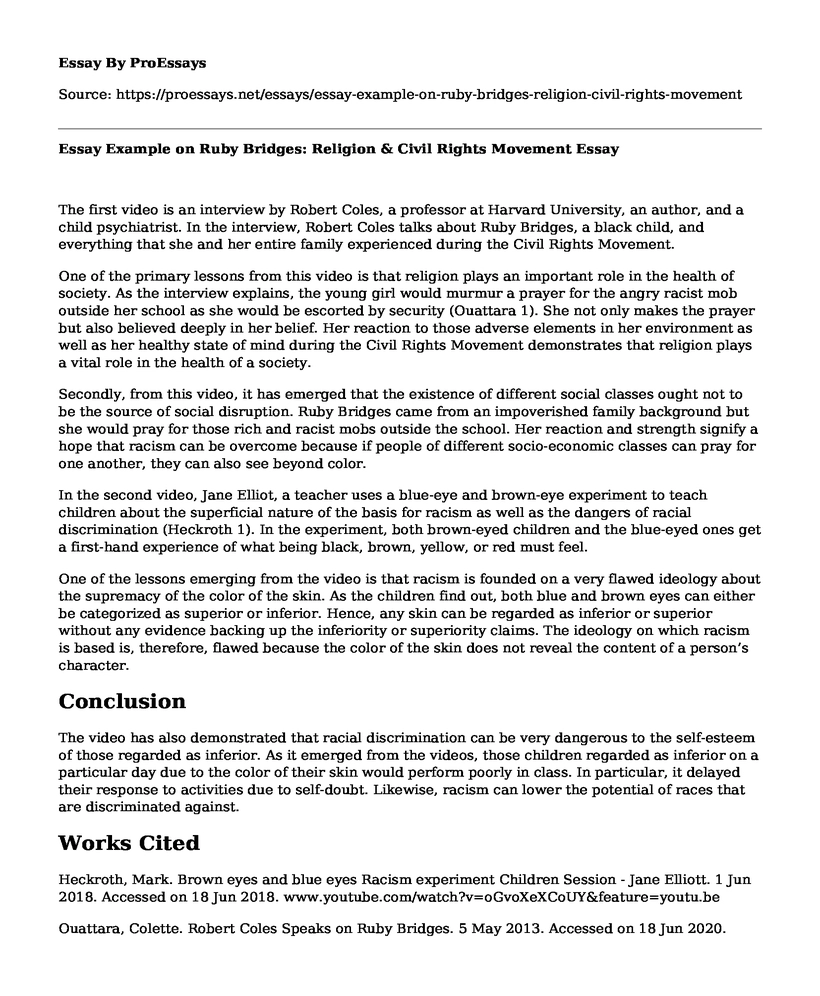The first video is an interview by Robert Coles, a professor at Harvard University, an author, and a child psychiatrist. In the interview, Robert Coles talks about Ruby Bridges, a black child, and everything that she and her entire family experienced during the Civil Rights Movement.
One of the primary lessons from this video is that religion plays an important role in the health of society. As the interview explains, the young girl would murmur a prayer for the angry racist mob outside her school as she would be escorted by security (Ouattara 1). She not only makes the prayer but also believed deeply in her belief. Her reaction to those adverse elements in her environment as well as her healthy state of mind during the Civil Rights Movement demonstrates that religion plays a vital role in the health of a society.
Secondly, from this video, it has emerged that the existence of different social classes ought not to be the source of social disruption. Ruby Bridges came from an impoverished family background but she would pray for those rich and racist mobs outside the school. Her reaction and strength signify a hope that racism can be overcome because if people of different socio-economic classes can pray for one another, they can also see beyond color.
In the second video, Jane Elliot, a teacher uses a blue-eye and brown-eye experiment to teach children about the superficial nature of the basis for racism as well as the dangers of racial discrimination (Heckroth 1). In the experiment, both brown-eyed children and the blue-eyed ones get a first-hand experience of what being black, brown, yellow, or red must feel.
One of the lessons emerging from the video is that racism is founded on a very flawed ideology about the supremacy of the color of the skin. As the children find out, both blue and brown eyes can either be categorized as superior or inferior. Hence, any skin can be regarded as inferior or superior without any evidence backing up the inferiority or superiority claims. The ideology on which racism is based is, therefore, flawed because the color of the skin does not reveal the content of a person’s character.
Conclusion
The video has also demonstrated that racial discrimination can be very dangerous to the self-esteem of those regarded as inferior. As it emerged from the videos, those children regarded as inferior on a particular day due to the color of their skin would perform poorly in class. In particular, it delayed their response to activities due to self-doubt. Likewise, racism can lower the potential of races that are discriminated against.
Works Cited
Heckroth, Mark. Brown eyes and blue eyes Racism experiment Children Session - Jane Elliott. 1 Jun 2018. Accessed on 18 Jun 2018. www.youtube.com/watch?v=oGvoXeXCoUY&feature=youtu.be
Ouattara, Colette. Robert Coles Speaks on Ruby Bridges. 5 May 2013. Accessed on 18 Jun 2020. www.youtube.com/watch?v=XPK3zQM2dHU&feature=youtu.be
Cite this page
Essay Example on Ruby Bridges: Religion & Civil Rights Movement. (2023, Sep 04). Retrieved from https://proessays.net/essays/essay-example-on-ruby-bridges-religion-civil-rights-movement
If you are the original author of this essay and no longer wish to have it published on the ProEssays website, please click below to request its removal:
- The Roles of FBI in Criminal Profiling Essay
- A Discussion on Improvement of the Gun Control Laws
- Research Paper on Role of the Police Force in Fighting Terrorism
- Chicano Movements 1960s - Essay Sample
- 'Courts Grant Offenders Rights: Slowing Down Investigation?' - Essay Sample
- US Chinese Sex Trafficking 1800-1890: Sexual Deviancy & Immodesty - Essay Sample
- Justifying the British Troop's Actions During the Boston Massacre: A foundation of History - Paper Sample







